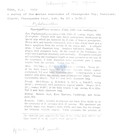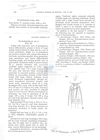
|
World Database of NematodesLinked to the Marine Biology Section, UGent |
| Start | Browse taxonomy |
Search taxonomy |
Search literature |
Search distributions |
Identification keys |
Media gallery | Editors | Statistics | Citations | Match taxa | Contact | Login |
CaRMS taxon detailsPtycholaimellus Cobb, 1920
marine, brackish
Cobb, N. A. (1920). One hundred new nemas (type species of 100 new genera). Contributions to a science of nematology. 9: 217-343., available online at https://www.biodiversitylibrary.org/page/18212644 [details]
Nemys eds. (2024). Nemys: World Database of Nematodes. Ptycholaimellus Cobb, 1920. Accessed through: Nozères, C., Kennedy, M.K. (Eds.) (2024) Canadian Register of Marine Species at: https://www.marinespecies.org/carms/aphia.php?p=taxdetails&id=2301 on 2025-04-09
Nozères, C., Kennedy, M.K. (Eds.) (2025). Canadian Register of Marine Species. Ptycholaimellus Cobb, 1920. Accessed at: https://www.marinespecies.org/carms/aphia.php?p=taxdetails&id=2301 on 2025-04-09
Date action by 2004-12-21 15:54:05Z created db_admin 2006-09-28 06:51:36Z changed Martinez, Olga
original description
Cobb, N. A. (1920). One hundred new nemas (type species of 100 new genera). Contributions to a science of nematology. 9: 217-343., available online at https://www.biodiversitylibrary.org/page/18212644 [details]
taxonomy source Muthumbi, A. W.; Vincx, M. (1998). Chromadoridae (Chromadorida: Nematoda) from the Indian Ocean: Description of new and known species. Hydrobiologia. 364: 119-153. (look up in IMIS) [details] Available for editors taxonomy source Chunming Wang.; Liguo An.; Yong Huang. (2015). A new species of free-living marine nematode (Nematoda: Chromadoridae) from the East China Sea. Zootaxa. 3947(2): 289., available online at https://doi.org/10.11646/zootaxa.3947.2.11 note: key to species [details] Available for editors taxonomy source Huang, Yong; Gao, Qun. (2016). Two new species of Chromadoridae (Chromadorida: Nematoda) from the East China Sea. Zootaxa. 4144(1): 89., available online at https://doi.org/10.11646/zootaxa.4144.1.4 note: Key to species [details] Available for editors basis of record Nemaslan: Biodiversity of Antarctic Nematodes (2004). (look up in IMIS) [details] additional source Hopper, B. E. (1969). Marine nematodes of Canada. II. Marine nematodes from the Minas Basin - Scots Bay area of the Bay of Fundy, Nova Scotia. Can. J. Zool. 47(4): 671-690. [details] Available for editors additional source Verschelde, D.; Nicholas, W.; Vincx, M. (2006). A Review of the Genera Croconema Cobb, 1920 and Pseudochromadora Daday, 1899 (Nematoda, Desmodoroidea): New Species from the Coasts of Kenya and Australia. Hydrobiologia. 571, 17-40. (look up in IMIS) [details] additional source Neave, Sheffield Airey. (1939-1996). Nomenclator Zoologicus vol. 1-10 Online. [Online Nomenclator Zoologicus at Checklistbank. Ubio link has gone]. , available online at https://www.checklistbank.org/dataset/126539/about [details] additional source Various Authors (2000). Nematode filing cabinet of the Marine Biology Section Ugent - in combination with the NemasLan Ms-Access database (published on CD-Rom, 2000) (look up in IMIS) [details] additional source Steyaert, M.; Moodley, L.; Vanaverbeke, J.; Vandewiele, S.; Vincx, M. (2005). Laboratory experiments on the infaunal activity of intertidal nematodes. Hydrobiologia. 540(1-3): 217-223. (look up in IMIS), available online at https://doi.org/10.1007/s10750-004-7145-4 [details] Available for editors additional source Venekey, V.; Fonseca-Genevois, V.; Santos, P. J. P. (2010). Biodiversity of free-living marine nematodes on the coast of Brazil: a review. Zootaxa. 2568: 39–66. [details] Available for editors additional source Derycke, S.; Van Vynckt, R.; Vanaverbeke, J.; Vincx, M.; Moens, T. (2007). Colonization patterns of Nematoda on decomposing algae in the estuarine environment: community assembly and genetic structure of the dominant species Pellioditis marina. Limnology and Oceanography. 52(3): 992-1001. (look up in IMIS) [details] Available for editors additional source Franco, M.; Steyaert, M.; Cabral, H.; Tenreiro, R.; Chambel, L.; Vincx, M.; Costa, M.; Vanaverbeke, J. (2008). Impact of discards of beam trawl fishing on the nematode community from the Tagus estuary (Portugal). Marine Pollution Bulletin. 56(10): 1728-1736. (look up in IMIS), available online at https://doi.org/10.1016/j.marpolbul.2008.07.003 [details] Available for editors additional source Guo, Y.; Helléouet, M.-N.; Boucher, G. (2008). Spatial patterns of meiofauna and diversity of nematode species assemblages in the Uvea lagoon (Loyalty Islands, South Pacific). Journal of the Marine Biological Association of the United Kingdom. 88(5), 931–940. [details] Available for editors additional source Jensen, P. (1986). The nematode fauna in the sulphide-rich brine seep and adjacent bottoms of the East Flower Garden, NW Gulf of Mexico. IV. Ecological aspects. Marine Biology. 92: 489-503. [details] Available for editors additional source Gobin, J. F. (2007). Free-living marine nematodes of hard bottom substrates in Trinidad and Tobago, West Indies. Bulletin of Marine Science. 81(1): 73–84. [details] additional source Integrated Taxonomic Information System (ITIS). , available online at http://www.itis.gov [details] ecology source Raes, M.; De Troch, M.; Ndaro, S. G. M.; Muthumbi, A.; Guilini, K.; Vanreusel, A. (2007). The structuring role of microhabitat type in coral degradation zones: a case study with marine nematodes from Kenya and Zanzibar. Coral Reefs. 26 (1): 13-126. [details] Available for editors ecology source Soetaert, K.. M. Vinckx, J. Wittoeck & M.Tulkens. (1995). Meiobenthic distribution and nematode community structure in five European estuaries. Hydrobiologia. 311: 185-206. (look up in IMIS) [details] Available for editors ecology source Fonsêca-Genevois, V.da., P.J. Somerfield, M.H. Baeta-Neves, R. Coutinho & T. Moens. (2006). Colonization and early succession on artificial hard substrata by meiofauna. Marine Biology 148(5):1039-1050., available online at https://doi.org/10.1007/s00227-005-0145-8 [details] Available for editors ecology source Van Colen, C.; Montserrat, F.; Verbist, K.; Vincx, M.; Steyaert, M.; Vanaverbeke, J.; Herman, P.; Degraer, S.; Ysebaert, T. (2009). Tidal flat nematode responses to hypoxia and subsequent macrofauna-mediated alterations of sediment properties. Marine Ecology Progress Series. 381: 189-197. (look up in IMIS), available online at https://doi.org/10.3354/meps07914 [details] Available for editors  Present Present  Inaccurate Inaccurate  Introduced: alien Introduced: alien  Containing type locality Containing type locality
|
Web interface and database structure initially created by Tim Deprez; now hosted and maintained by VLIZ
Page generated 2025-04-10 · contact: Tânia Nara Bezerra or info@marinespecies.org






